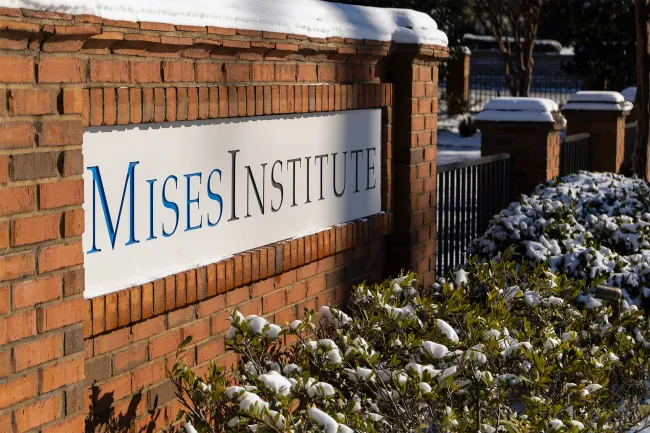While Democrats and Republicans may argue over many issues, there is one thing they can agree on: a firm, bipartisan commitment to bad economics. Case in point: On June 10, Senators Josh Hawley (R-Mo.) and Peter Welch (D-Vt.) teamed up to introduce the Higher Wages for American Workers Act (S. 2013)—a bill aimed at doubling the federal minimum wage from $7.25/hour to $15/hour, which also includes provisions that would allow the minimum to increase with inflation in subsequent years.
Blaming “woke” corporations and illegal immigrants for the American worker’s woes is nothing new in President Trump’s ongoing efforts to continue the GOP’s rebranding as the right-wing populist party of the middle class. However, Hawley’s platform is unique. His minimum wage bill hinges on the idea that the failure of minimum wages to keep up with inflation is a primary reason behind the claim that working-class incomes have stagnated in recent decades. This common talking point—often brought up repeatedly by the left—has been debunked time and again, but still shapes his approach. This—coupled with his other left-leaning economic policies—is a stark deviation from the conservative orthodoxy and has prompted hesitation from President Trump himself.
Trump’s criticism isn’t without merit. Republicans have resisted federal minimum wage hikes for 15 years, and this bill only brings back an economic failure they’ve long fought against. Hawley’s proposal, while perhaps well-intentioned, is both a reckless and destructive policy that will undermine the economic prospects of the very workers it purports to help, and fail to address the issues it purports to solve. Despite the profundity of evidence demonstrating its shortcomings, Hawley and Welch’s reintroduction of the minimum wage into the national conversation on economic justice requires a renewed confrontation with their flaws.
In all fairness, Hawley’s concerns are not entirely misplaced. Americans in red and blue states alike have had a difficult time making ends meet. Housing, groceries, and other essentials are increasingly unaffordable, and inflation has deprived American workers of valuable savings and purchasing power. It is an indisputable fact that people cannot afford the same lifestyle that $7.25/hour bought them in 2009.
However, when it comes to crafting policy, sounding the alarm is no substitute for a plan that actually works, and Hawley’s bill misses the mark entirely. Rising grocery store prices are partly due to strained supply chains (part of which can be blamed on the tariffs) that have caused chronic shortages, higher production costs, and consumer anxiety. The lack of affordable housing is due to barriers to housing supply that are exacerbated by a slew of miasmatic government-imposed restrictions, including rent control, impact fees, parking mandates, outdated building codes, and zoning laws, among other land-use regulations. Raising the minimum wage will do nothing to redress any of these structural issues.
Beyond the perverse notion that more government is the solution to a problem caused by government, Hawley’s solution prescribes cough syrup for a broken leg—it’s the wrong remedy for the wrong ailment and completely misses the scale and nature of the problem. Moreover, far from simply being an impotent solution to a deeper problem, this new bill—and all minimum wage laws for that matter—are terrible anti-poverty policies that only hurt the very workers they aim to help.
One of the most fundamental principles of supply and demand is that if the price of something goes up, people will buy less of it. As famed economist Henry Hazlitt points out, the same principle applies to labor just like any other good or service because a wage is, fundamentally, a price. In this case, a wage is the price that an employer is willing to pay for labor, and if a binding price floor that exceeds the market equilibrium is imposed (i.e, a minimum wage law), the supply of people willing to work for that price will exceed the demand for that work, resulting in unemployment.
In practice, when governments impose a law that states “no one shall be paid less than $15/hour,” they are, in effect, saying “someone whose work is worth less than $15/hour will not be employed at all.” While some workers may benefit from more pay due to a higher minimum wage law, this would mean little to a worker who loses their job as a result, and people have been pointing out the negative impacts minimum wage laws have on unemployment for years.
In this case, a $15/hour minimum wage may benefit some of the 1 percent of Americans who earn at or below the federal minimum wage, but at the cost of losing over 800,000 jobs in the restaurant industry alone and 1.4 million jobs overall. The most adversely affected are teens, young adults, and the less educated. 43 percent of minimum wage workers are under 25, who already have an unemployment rate significantly higher than the national average. From 2006 to 2009, federal minimum wage hikes accounted for 43 percent of the decline in employment among low-skilled workers during the Great Recession, with minorities being hit especially hard.
Even those willing to work for less than the minimum wage mandate would be excluded from employment. Many employers who would hire employees for a cheaper wage, and prospective workers willing to work for a cheaper wage—particularly young workers just starting their careers who will miss out on opportunities to develop professional skills they wouldn’t pick up in a classroom—are both barred from the labor market. To quote economist E.J. Antoni, if Hawley’s goal is to eliminate jobs, especially starter jobs that people need to climb the ladder of access, then this new bill is a surefire way to do it.
For those who do keep their jobs, many of them can expect to have their hours cut as businesses attempt to reduce costs, which both depresses their wages and impacts their eligibility for employee benefits. Even assuming overall employment rates remain constant, the results from past minimum wage hikes of just $1 added net losses of at least $1,590 per employee, equivalent to 11.6 percent of workers’ total wage compensation.
Beyond the disastrous effects that raising the minimum wage would have on employment for the low-skilled and entry-level jobs, Hawley’s bill to raise the minimum wage would only make life less affordable for people occupying these jobs. Just as higher wages can lead to fewer workers being employed due to the cost of labor exceeding the market equilibrium, the same principle applies to consumer goods: When the cost of production rises, businesses are forced to respond. Given that most businesses do not have the margins to internalize these higher costs, they must either cut back on production or labor costs (both of which lead to lower employment), which counterbalances the supposed increase in wages.
Washington State, DC, and California have some of the highest minimum wage laws in the country, but these states are far from middle-class affordability havens. Studies on the impact of minimum wage increases tend to reveal that the costs of artificially higher wages are often indirectly passed through to consumers, particularly in the retail and grocery industries. Higher production costs lessen production and, if demand remains constant, prices increase. These higher prices hit low-income individuals especially hard, as they bear the brunt of diminished purchasing power.
Josh Hawley may be attempting to hide his policy behind a veneer of right-wing rhetoric and jargon, but no amount of political grandstanding will change the fact that a spade is still a spade: This is a horrible, progressive idea. Minimum wage laws cannot solve the poverty problem and simply shifting wealth around doesn’t create it.
In the end, no top-down mandate will raise real wages for American workers. The best way to raise real wages for employees is to raise the value of the workers’ labor, which can be achieved through capital investment, education, training, and experience. Real wages come out of production, not government decree.
As Thomas Sowell once said, “There are no solutions; only trade-offs.” In this case, the trade-off is artificially inflated wages for a select class of workers who keep their jobs, while many others will lose their jobs because their labor isn’t worth the price. For those who manage to keep their jobs, they’ll likely face reduced hours, cuts to other employee benefits, and sped up displacement from automation. Meanwhile, everyone will feel the pinch as businesses deal with the increased costs of this market distortion.
Bad economics is bipartisan, as are the consequences of bad economics. The one-size-fits-all solution of attempting to solve a complex issue like poverty with a uniform federal minimum wage will bring disaster to the same low-income workers that Hawley and many populists aim to protect, leaving everyone worse off overall. If Republicans in Congress have any sense, they will kill this bill in its cradle. There are plenty of ways to own the libs, but stealing their bad policies is not one of them.


